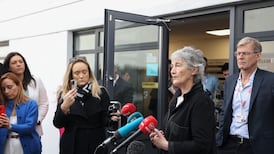The table on which the proclamation of the short-lived Republic of Connacht was signed following the French invasion of Ireland in 1798, and an exceedingly rare copy of James Joyce’s denunciatory 1904 poem The Holy Office, were among the invaluable objects that perished in the burning of so-called big houses in Galway and Mayo a century ago this winter.
Moore Hall in south Mayo, the home of the writer George Moore and his Free State Senator brother Maurice, and Renvyle House in Connemara, owned by the surgeon, writer and Senator Oliver St John Gogarty, were both burned to a shell within weeks of each other in February 1923.
The burnings followed an order by the general headquarters staff of the anti-Treaty IRA in late January to destroy the houses of “Free State Senators” in reprisal for the executions of anti-Treaty prisoners in the latter months of the Civil War.
The imposing Moore Hall mansion, built in the 1790s to overlook Lough Carra at Ballyglass, near Claremorris, was burned on February 1st. “Since the burning down of my house, I don’t think I shall ever be able to set a foot in Ireland again”, George Moore wrote to a friend. He said in a letter to the London Times that he had tried “to dissociate my house from politics” and he blamed the burning on his brother’s “acquiescence in his election to the Senate and the speeches he has delivered in the Senate”.
READ MORE
The brothers had been estranged for many years, during which time neither of them lived in Moore Hall. It had been occupied by Free State forces and used as a training base before the fire, which destroyed documents relating to the French Revolution as well as the 1798 table.
Senator Moore, who had been a member of the Connaught Rangers and later of the Irish Volunteers before his election to the first Seanad, made no reference in the chamber to the burning of his ancestral home until March 28th, the last sitting before the Easter recess. During a debate on the Damage to Property (Compensation) Bill, he said: “It would seem that the idea of some of the people who are causing all the destruction in the country is that we should revert back to the wooden hut and houses of clay that the Gaels of old lived in”.
He was responding to William T Cosgrave, the president of the Executive Council, whose own home, near Rathfarnham, had been maliciously set on fire in January. Introducing the Bill in the Seanad, Cosgrave said: “Members of this Seanad have suffered, suffered perhaps in respect to their numbers more seriously than any other institution in the country”.
The houses of 37 senators were burned during January and February 1923, according to the Oliver St John Gogarty biographer Ulick O’Connor. Some 17 big houses were destroyed in Galway alone during the Civil War, UCD historian Úna Newell has estimated.
Gogarty’s Renvyle House was burned down in late-February, a month after he had escaped death by swimming across the freezing river Liffey when six armed men abducted him from his Dublin home. Letters from his sometime friend James Joyce were incinerated with the rare copy of Joyce’s 1904 poem. “Nothing left now but memories”, Gogarty wrote, “Books, pictures, all consumed: for what? Nothing left but a charred oak beam quenched in the well beneath the house. And ten tall square towers, chimneys, stand bare on Europe’s extreme verge”.
Like Moore, Gogarty made no reference in the Seanad during February or March to the burning. He transferred his medical practice to Grosvenor Street in Mayfair, London, for a time, saying he would not betray the Irish government, or live where there was “resistance to civilisation”. The owner of Spiddal House, Galway county councillor Lord Killanin, had moved permanently to London before his home was burned down in April following an earlier raid.
The unoccupied south Galway home of the poet Senator William Butler Yeats, Thoor Ballylee, was ransacked and robbed in late January. Also in January, another Galway mansion, Castlehackett House, near Tuam, was burned to the ground. “The fine library, magnificent ballroom, and valuable family oil paintings were destroyed,” reported the Galway Observer.
Renvyle House, rebuilt by Gogarty, is now a four-star hotel; Thoor Ballylee is a tourist attraction; Spiddal House, also restored, is where the Waterboys recorded their 1988 album Fisherman’s Blues.
Moore Hall, in contrast, would be a fitting location for a novel that George Moore titled but never wrote: “Ruin and Weed”.














